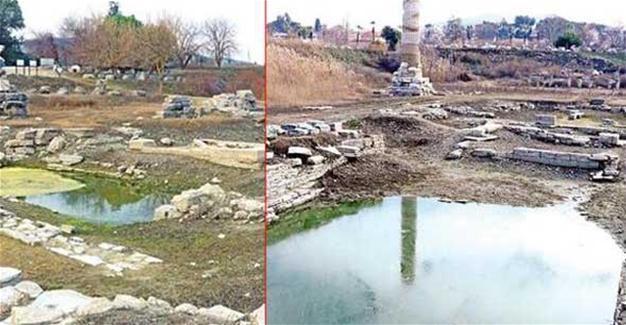Temple of Artemis turns into swamp due to neglect
Ömer Erbil – İZMİR

The Temple of Artemis in the Selçuk district of İzmir has turned into a swamp because of neglect and a lack of interest by authorities.
The temple, which is among the Seven Wonders of the Ancient World and on the UNESCO Cultural Heritage List, draws millions of tourists each year.
The temple, which was visited by tourists who come to the district to see the famous site of Ephesus, welcomes tourists with a rusted introduction panel. The temple resembles an empty, abandoned field with no environmental planning and traveling routes. Excavation holes in the temple area have been filled with rainwater, while security in the area is lacking.
Authorities at the Ephesus Museum said a project that they have been working on for a long time regarding the temple has been approved by the preservation board.
Noting their discontent with the current situation of the historic temple, authorities said the first step would be to conduct environmental planning for the environs of the temple, subject to permission from the Culture and Tourism Ministry.
Authorities will then seek to contain water in the area and create a mock-up of the temple in a visible spot to inform visitors about the historic aspects of the structure.
There are several warnings at the entrance of the temple, which are as follows:
-Don’t enter forbidden zones (There are no forbidden zones)
-Don’t step on the pieces (There are no officials around to warn visitors not to do so)
-Don’t scratch the pieces (There are no officials to check)
-Don’t take pieces from the temple (There are no officials or cameras to check)
-Don’t touch electric cables (There are no warnings near the cables)
The ancient temple was built on the orders of Croesus, the king of Lydia, between 560 and 550 BC. The construction of the temple lasted for 10 years, but it was destroyed by Herostratus, a fourth-century BC Greek arsonist who sought notoriety by ruining the temple in 356 BC. The structure was then rebuilt with the same width and length but was three meters higher.
The structure, which is 55.10 by 115 meters and was famous for its marble statues, was the biggest temple in the Hellenistic era. The temple, however, was not repaired after it was demolished by invading Goths in around 262 A.D.
The first archeological excavations in Ephesus was started in 1869 by J.T. Wood on behalf of the British Museum. A number of artifacts found in the excavations were taken to the British Museum. In addition, there are a number of pieces from the Temple of Artemis in the Vienna Museum in Austria.
There are two grand Artemis sculptures on display at the Ephesus Museum. After the pieces from the temple were taken by the British and the Austrians, there were only architectural pieces, such as pieces of marble, pillars and pulleys, left in the area. Only one pillar is exhibited in the temple area, while the other architectural pieces can be seen dispersed around the area.
The land on which the temple is located belongs to the heirs of Professor Otto Bendorf from Vienna University, who began excavations in 1893. The Turkish Culture and Tourism Ministry has the right of usage for the Temple of Artemis.
 The Temple of Artemis in the Selçuk district of İzmir has turned into a swamp because of neglect and a lack of interest by authorities.
The Temple of Artemis in the Selçuk district of İzmir has turned into a swamp because of neglect and a lack of interest by authorities.